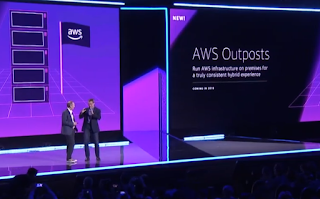 In perhaps its most significant announcement at this week's re:Invent conference in Las Vegas, Amazon Web Services unveiled plans to offer pre-configured compute & storage hardware racks for deployment in customers' private data centers. The hardware will be fully managed by AWS, allowng customers to run compute and storage on-premises, while seamlessly connecting to the rest of AWS’s broad array of services in the cloud. The service is currently in private preview and AWS expects it will be widely available in the second half of 2019.
In perhaps its most significant announcement at this week's re:Invent conference in Las Vegas, Amazon Web Services unveiled plans to offer pre-configured compute & storage hardware racks for deployment in customers' private data centers. The hardware will be fully managed by AWS, allowng customers to run compute and storage on-premises, while seamlessly connecting to the rest of AWS’s broad array of services in the cloud. The service is currently in private preview and AWS expects it will be widely available in the second half of 2019.
AWS Outposts come in two variants; first, an extension of the fast-growing VMware Cloud on AWS service that runs on AWS Outposts; second, AWS Outposts that allow customers to run compute and storage on-premises using the same native AWS APIs used in the AWS cloud.
VMware Cloud on AWS Outposts, delivers the entire VMware Software-Defined Data Center (SDDC) - compute, storage, and networking infrastructure - to run on-premises and managed as a Service from the same console as VMware Cloud on AWS, using AWS Outposts and enables customers to take advantage of the ease of management and integration with AWS services.
The AWS native variant of AWS Outposts is aimed at customers who prefer the same exact APIs and control plane they’re used to running in AWS’s cloud, but on-premises. This variant allows customers to run other software with native AWS Outposts, starting with a new integrated offering from VMware called VMware Cloud Foundation for EC2, which will feature VMware technologies and services that work across VMware and Amazon EC2 environments, like NSX (to help bridge AWS Outposts to local data center networks), VMware AppDefense (to protect known good applications), and VMware vRealize Automation (for workload provisioning).
“Customers are telling us that they don’t want a hybrid experience that attempts to recreate a stunted version of a cloud on-premises, because it’s perpetually out of sync with the cloud version and requires a lot of heavy lifting, managing custom hardware, different control planes, different tooling, and manual software updates. There just isn’t a lot of value in that type of on-premises offering and that’s why these solutions aren’t getting much traction,” said Andy Jassy, CEO of AWS. “So we started with what our customers were asking for and worked backwards. They told us they want an extension of their AWS or VMware Cloud on AWS environment on-premises, using the same hardware we’re using, the same interfaces, the same APIs, the same instant access to the latest AWS capabilities the minute they become available, and they don’t want to manage hardware or software. So, we tried to reimagine what customers really wanted when running in hybrid mode, and developed AWS Outposts.”
“VMware Cloud on AWS broke the barriers between the data center and the cloud by combining the best of the private cloud and public cloud in the AWS cloud,” said Pat Gelsinger, chief executive officer, VMware. “Today we expand our strategic collaboration with AWS to provide our mutual enterprise customers with more choice and options as they extend their hybrid cloud environments to drive agility, simplicity, security, and full infrastructure interoperability.
Other highlights from Day 3:
- AWS announced 13 new machine learning capabilities and services, across all layers in the machine learning stack.
- 85% of TensorFlow workloads are already on AWS
- AWS has significatly improved the way in which TensorFlow distributes training tasks across GPUs, enabling close to linear scalability when training multiple types of neural networks (90 percent efficiency across 256 GPUs, compared to the prior norm of 65 percent). U
- AWS announced its own high performance machine learning inference chip called AWS Inferentia. It was developed by the Annapurna team. The new inference processor provides hundreds of teraflops per chip and thousands of teraflops per Amazon EC2 instance for multiple frameworks (including TensorFlow, Apache MXNet, and PyTorch), and multiple data types (including INT-8 and mixed precision FP-16 and bfloat16)
- Hundreds of companies are standardizing their machine learning workloads on AWS SageMaker. Customers include Adobe, BMW, Cathay Pacific, Dow Jones, Expedia, Formula 1, GE Healthcare, HERE, Intuit, Johnson & Johnson, Kia Motors, Lionbridge, Major League Baseball, NASA JPL, Politico.eu, Ryanair, Shell, Tinder, United Nations, Vonage, the World Bank, and Zillow.
- Amazon SageMaker Neo (generally available now) is new deep learning model compiler that supports hardware platforms from NVIDIA, Intel, Xilinx, Cadence, and Arm, and popular frameworks such as TensorFlow, Apache MXNet, and PyTorch. AWS will also make Neo available as an open source project.
- Introduced an AWS Marketplace for machine learning -- 3rd party algorithms and tools that plug into SageMaker
- The Amazon Aurora database is the fastest growing service in the history of AWS and now tens of thousands of customers
- AWS announced two new purpose-built database services, Amazon Timestream, a fast, scalable, and fully managed time series database for IoT and operational applications and, Amazon Quantum Ledger Database (QLDB), a highly scalable, immutable, and cryptographically verifiable ledger.
- A new AWS Control Tower gives customers an automated “landing zone” for setting up their multi-account environment and continuously govern their AWS workloads with rules for security, operations, and compliance.
- A new AWS Security Hub wil provides centralized management for security and compliance. It will be open for 3rd party add-ons.
- A new AWS Lake Formation service will make it easier to set up a secure data lake
- New Amazon S3 Intelligent-Tiering optimizes storage costs by automatically selecting the most cost-effective storage tier based on usage patterns.
- Amazon S3 Glacier Deep Archive is a new storage class priced at just $0.00099 per GB-month (less than one-tenth of one cent, or $1 per TB-month)
- Guardian Life Insurance has gone all-in with public cloud and closed its last data center. Guardian named AWS as its preferred cloud provider.
- Open Bank, a subsidiary of Santander Group with 1.3 million customers in Spain, has gone all-in on AWS.























